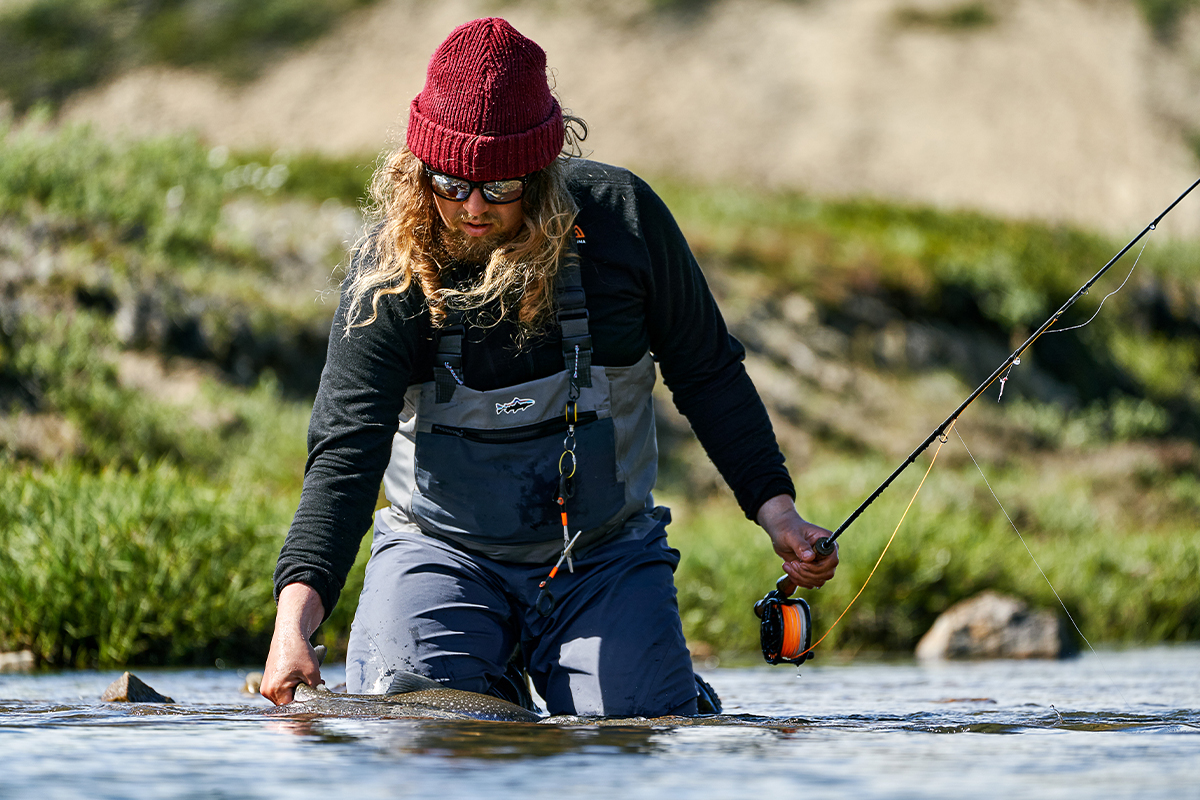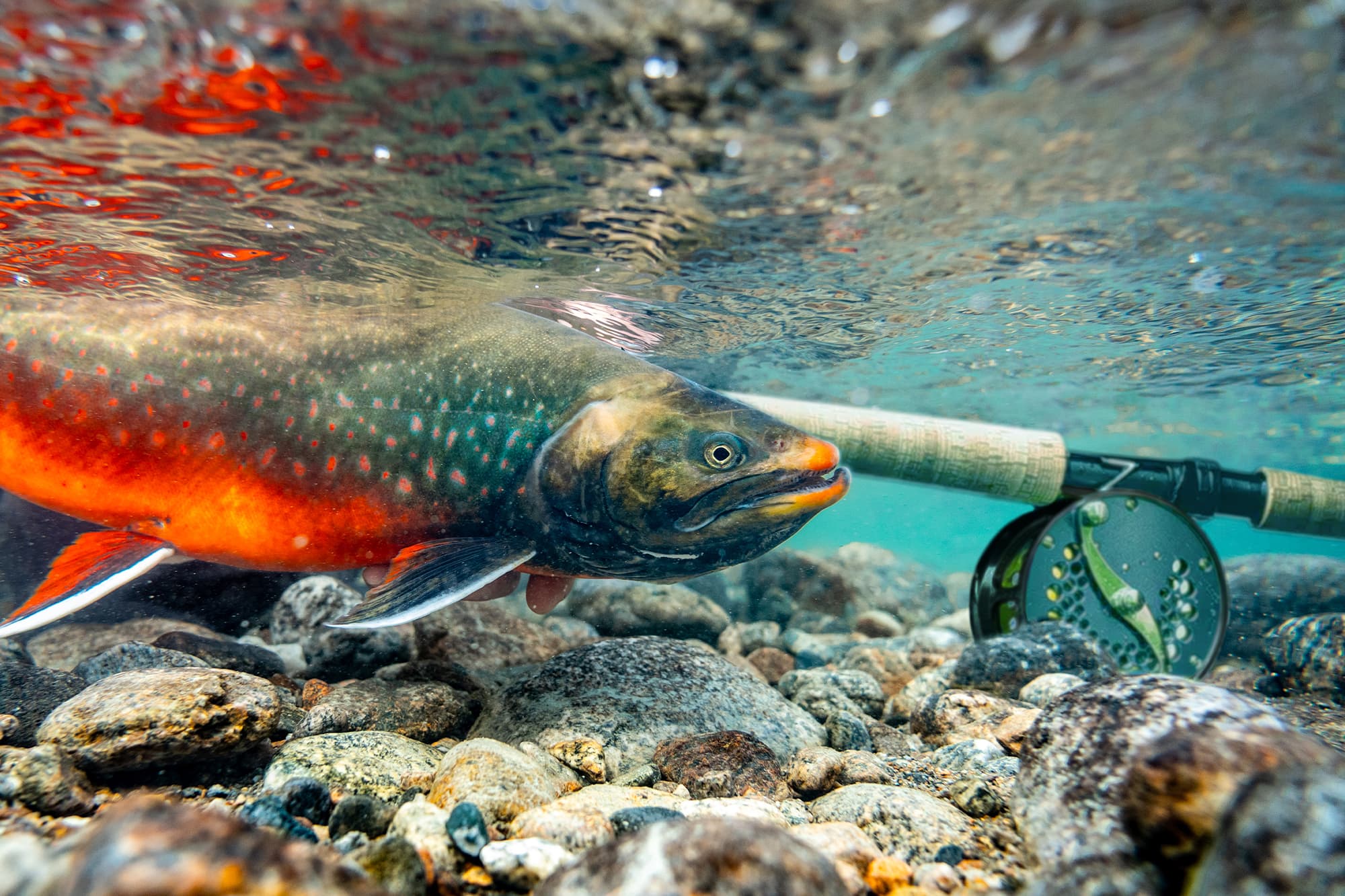Catching Fire
Author information

Greenland
Jay Bartlett
17 min read
Few angling experiences compare to fly fishing for sea-run Arctic char in Greenland’s pristine rivers, lakes, and streams. These powerful, hard-fighting fish demand both finesse and strength from your setup if you are to contend with the largest specimens out there.
Whether you’re skating a foam fly across glassy pocket pools and canyon rapids, stripping a streamer through deep gravel drop-offs, or delicately drifting a nymph whilst sight fishing for a trophy char, having the right fly fishing gear for Greenland rivers and tactics can make all the difference.
In this guide, I’ll share the best rigs for Arctic char, setups, and tactics I use when targeting Arctic char in Greenland, as well as conservation practices to ensure this incredible fishery thrives for future generations.
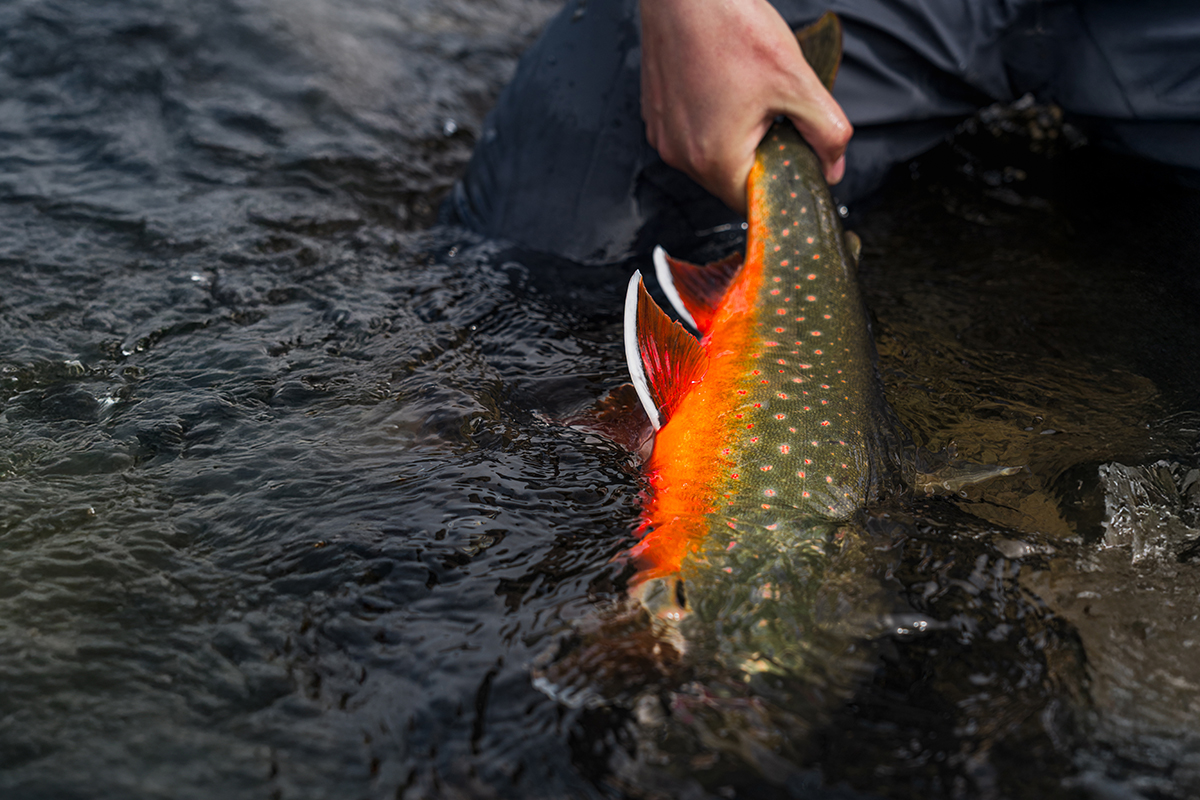
The Ideal Set Up for Arctic Char
When it comes to fly rods and reels, the ZX Single-hand and Z1 Switch range is my go-to choice. These rods strike the perfect balance between lightweight responsiveness, wind cutting stability and the backbone needed to handle aggressive, sea-run Arctic char.
- ZX Single-hand 593 and 693: Versatile for everything from surface skaters to sunk-line streamer fishing and heavy nymphing.
- Slightly longer design: At 9’3” these rods offer a great balance of precise distance when casting and line control whilst fishing in Greenland’s varied waters, without suffering tracking issues in strong winds.
- Fighting butt: A huge advantage when battling these strong, reel-emptying fish, providing comfort against your body or support when pressured against your forearm, and room for the reel to turn freely when the fish take an unexpected run avoiding the dreaded catching on clothing.
- Slightly longer design: At 9’3” these rods offer a great balance of precise distance when casting and line control whilst fishing in Greenland’s varied waters, without suffering tracking issues in strong winds.
- Z1 Switch 4110: When fishing larger rivers with tight back casting or needing to target fish at distance, a light-weight trout spey switch rod not only gives you precise distance with minimal effort from waterborne casts, but also allows for greater line control, keeping your flies in the strike zone longer without being too heavy on the fish when hooked up. A #4 switch will give a similar feel to a single-hand #6 and all the nostalgia of swinging for Atlantic salmon or sea trout.
On Greenland’s waters, ranging from wide-open river runs and lakes to skinny canyon rapids and riffling streams, I like to carry two dedicated setups, the best rigs for Arctic char. One for topwater (dry flies) and one for subsurface (streamers and nymphs). I may also swap out one of the rigs for a Switch setup with a versitip line to cover greater distances and quickly switch from floating tips for topwater flies and sink tips for streamers or my favourite hybrid streamer / nymph rigs.
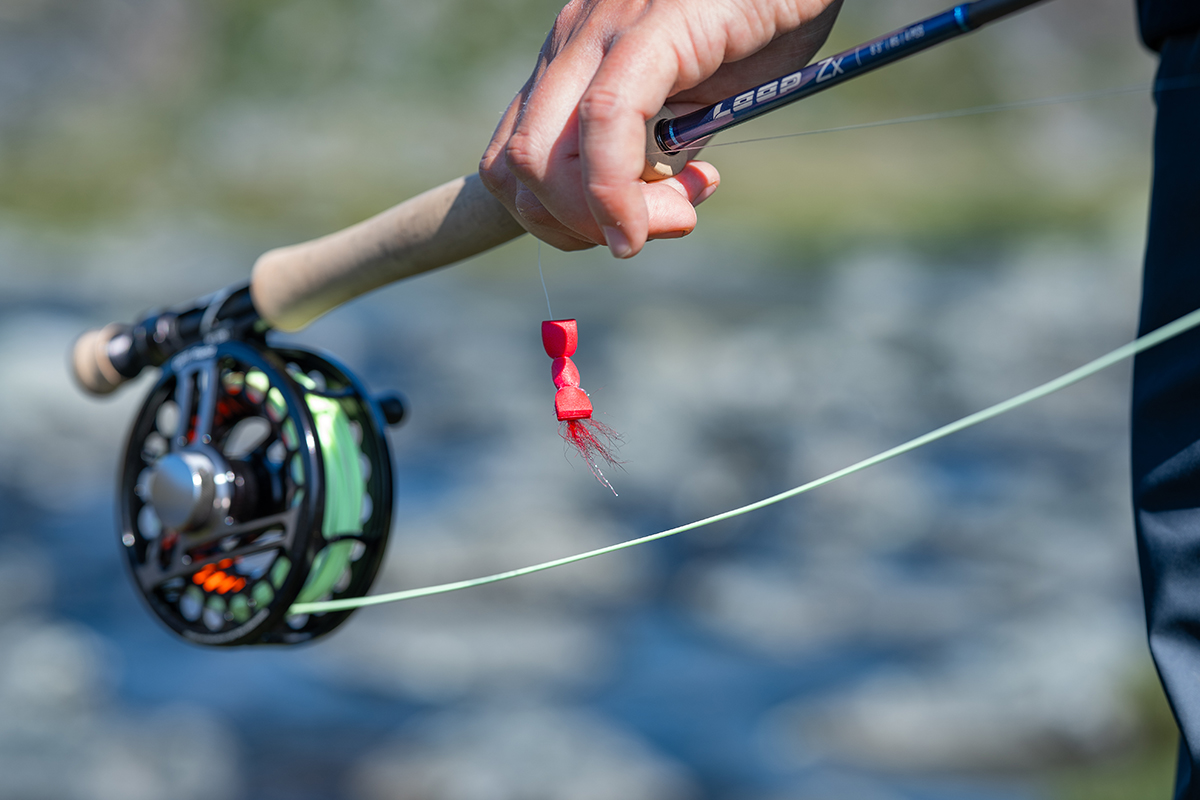
Dry Fly Fishing Arctic Char – For Explosive Topwater Takes
Few things match the adrenaline of dry fly fishing Arctic Char and watching a Char smash a foam fly off the surface. The best chances come in shallow areas tight to the banks, in pool tails, or in pocket waters around rocks and rapids.
Dry Fly Setup:
- Rod: ZX Single-hand 593
- Line: #5 SST Dry Fly Line (aggressive taper, perfect for bulky foam flies)
- Reel: Opti Rapid (lightweight, oversized capacity for backing and fast retrieval)
- Leader: 9–12 ft mono tapered leader (0.30mm or stronger for abrasion resistance)
This rig excels at precision casting into tight margins or compressed pockets of water. I typically use a 12ft leader for open water where more time is needed for the fly to skate or a 9 ft leader in rapids and canyons where accuracy and control needs to be close in and with a short time frame for success.
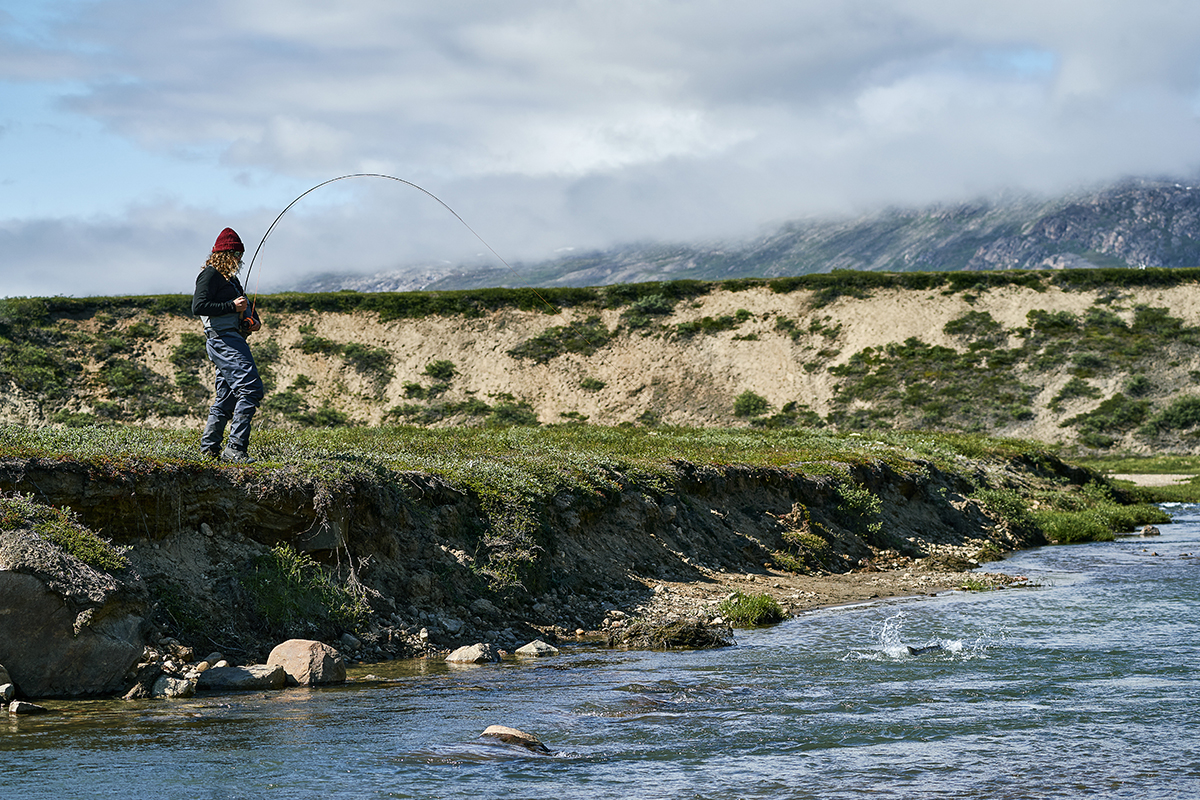
Streamer Fishing Arctic Char – Getting Down to the Big Fish
While surface takes are exhilarating, streamer fishing Arctic char is essential when char hug the bottom, especially the larger individuals. When they won’t rise, you need to get down into their strike zone.
Wet Fly Setup
- Rod: ZX Single-hand 693
- Line: #6 Opti Stream Floating Line (short head, ideal for tight casting or single-hand spey)
- Reel: Evotec G5 #5-8 (dependable drag, large capacity for long runs)
- Leader Options:
- 9–12 ft fluorocarbon leader
- OR 5 ft sinking poly leader + 6–9 ft fluorocarbon tippet
- 9–12 ft fluorocarbon leader
Fly Selection
- Heavy, bright streamers
- Medium weight sparse streamers
- Light, mobile zonker streamers
- Sparkly tungsten nymphs
This rig is deadly in deep pools and canyon runs where char hold low and wait for food to come to them, though with enough movement in the right conditions you can trigger them to rise just enough to hit them and hit them hard!
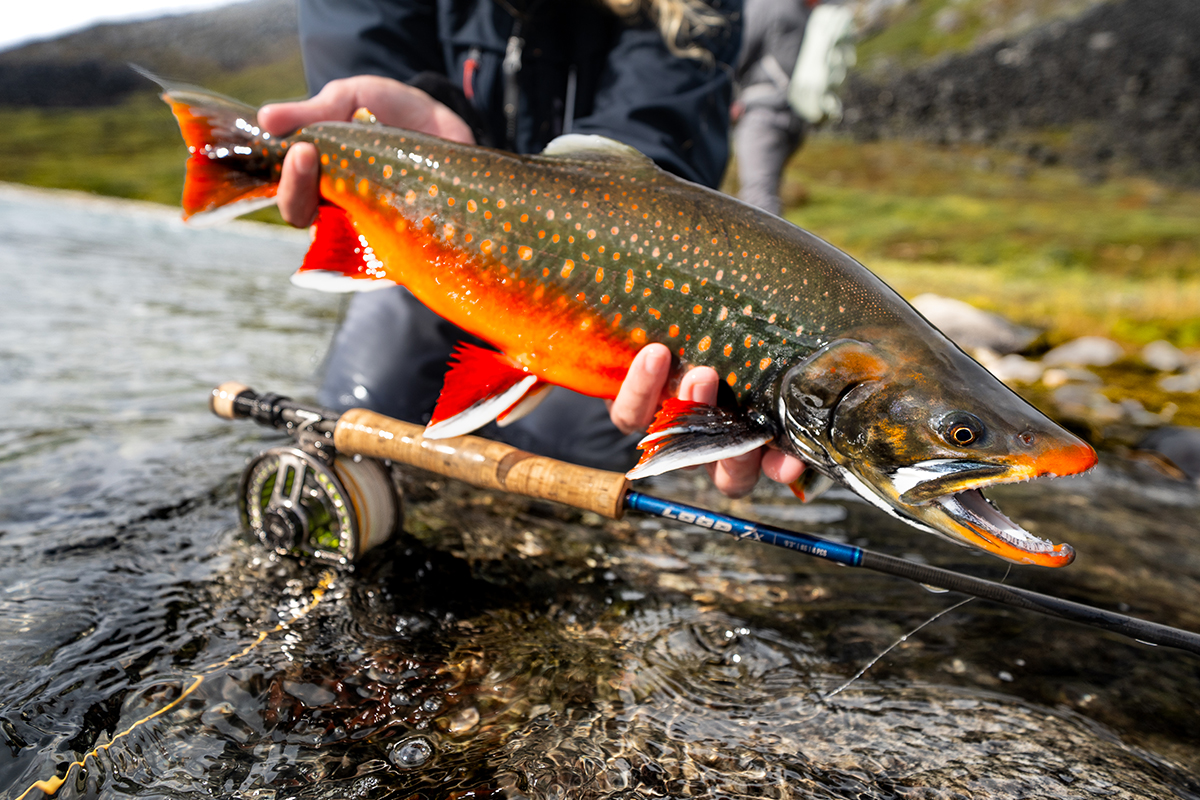
Hybrid Switch Rig – Distance and Nostalgia
When fishing big rivers or seeking greater distance on lakes, a longer light 2-handed setup with a versitip line allows quick switching between topwater and sunk-line tactics. Fishing with a 2-handed setup, though much lighter than salmon or sea trout setups, still gives you that feeling and rush of swinging and waiting for that familiar gentle tug at the other end.
Topwater Leader System:
- Rod: Z1 Switch 4011
- Line: #4 or #5 SDS Switch Kit (floating belly head, tips ranging from float / intermediate / sink 3 to cover topwater to sinking tactics)
- Reel: Classic #5-8 (dependable drag, nostalgic sound and feel)
- Leader Options:
- 9–12 ft monofilament leader (topwater with floating tip)
- 9–12 ft fluorocarbon leader (sinking with intermediate or sink 3 tip)
- 9–12 ft monofilament leader (topwater with floating tip)
Fly Selection:
- Foam flies (floating only)
- Heavy, bright streamers
- Medium sparse streamer patterns
- Light, mobile zonkers
- Sparkly tungsten nymphs
This rig is perfect for covering larger bodies of water and tight casting situations where waterborne casts are required.
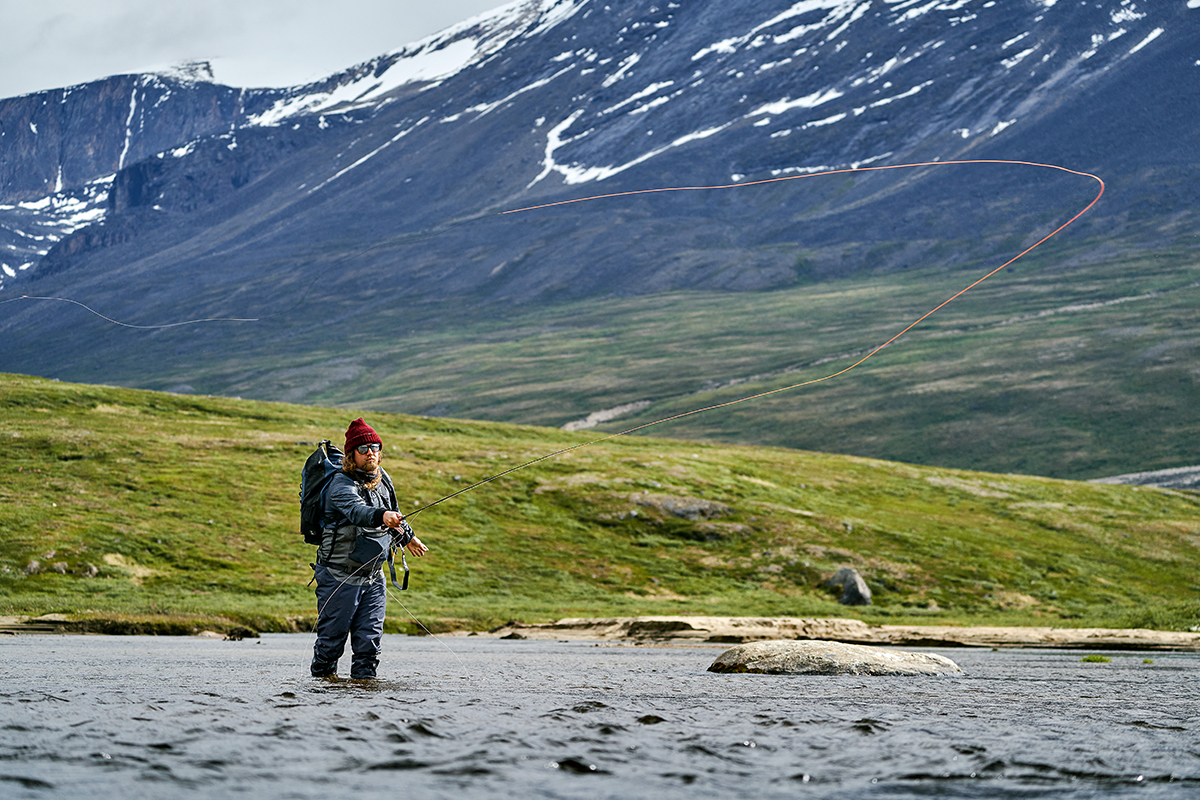
My Favourite Rig – The Tandem Fly Setup (Hybrid Nymphing)
After years of experimenting, my most productive setups for topwater and subsurface – the nymph rigs for Arctic char – turned out to be a happy accident. Tentative takes and poor hook ups on bigger flies prompted a change and by quickly tying an extended leader to the hook bend of the first fly down to a small nymph quickly changed the game.
Topwater Leader System:
- 9 ft of 16 lbs (.37mm) monofilament → bright foam fly
- 5–6 ft of 12lbs (.33mm) monofilament → bright #10 tungsten bead nymph
Subsurface Leader System:
- 5–10 ft extra super-fast poly leader
- 5–6 ft of 20 lbs (.37mm) fluorocarbon → sparsely dressed 5-hair fly
- 5–6 ft of 16 lbs (.33mm) fluorocarbon → bright #10 tungsten bead nymph
Fishing these rigs swinging the flies casting 90 degrees or 45 downstream, or with the subsurface rig actually dead drifting by casting upstream 45 degrees has consistently produced not just numbers, but bigger fish. Unsurprisingly, my largest char often take the nymph rather than the streamer.
Question is why? My theory is that char are attracted to big bright colours and younger smaller fish will often go ahead and take right away, however older wiser fish are noticeably more cautious. I have observed many times these bigger fish reacting to and gently taking smaller offerings as if they were casually feeding, but also inspecting and then rejecting larger options often by turning sharply and circling back to their lie.
So why not just fish a single nymph? The theory here is that the larger streamer acts as an attractor, something to move the fish off of their lie, then if they reject the larger fly they will turn and see the nymph and take that instead. Alternatively the nymph is also a great way to get down to the fish quickly as it has less mass and cuts through the water more effectively than a large fly being held up in or swept away by the current, so often the nymph presents right in front of their nose and they have very little time to inspect it, triggering an instant response.
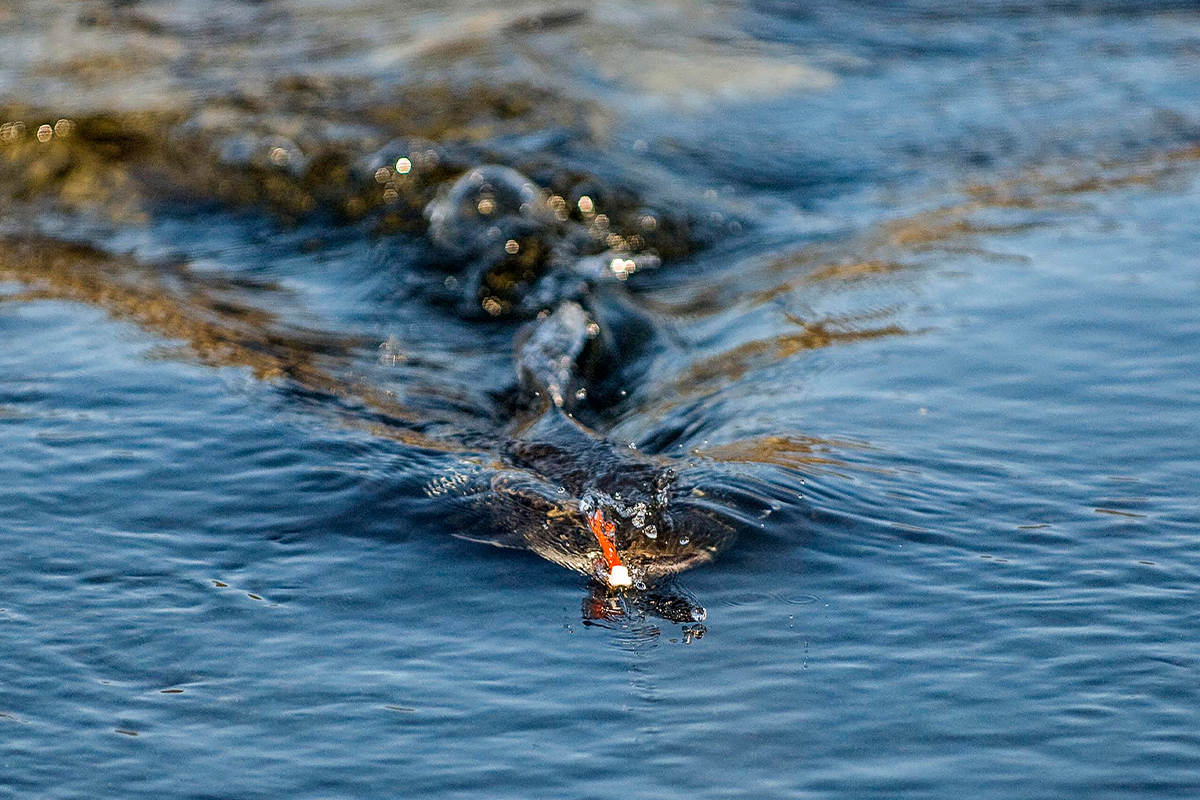
Understanding Arctic Char Behaviour
To fish big Arctic char successfully, you need to understand their unique lifecycle and feeding habits:
- Life Cycle: Arctic char are long-lived, slow growing, cold water species and spend most of their lifecycle in freshwater. Each spring they head to sea for a short period to feed heavily before returning to freshwater to overwinter and or spawn.
- Feeding: Opportunistic and aggressive. They respond strongly to bright and metallic colours like orange, pink, red, light purple, chartreuse, silver, likely mimicking eggs, juvenile char, or decaying fish flesh of char that have reached the end of their life.
- Takes: Streamer strikes are explosive and aggressive, while nymph takes are often subtle, requiring careful attention to line placement and the fish’s reaction to different presentations.
- Feeding vs. Territorial Response: Arctic char, like sea trout, will feed in freshwater as well as at sea, the major difference being that available food in freshwater, at least in Greenlandic freshwater is significantly less than at sea.
When running the river early in the season, takes are more likely to be a feeding response, therefore larger flies more frequently result in smaller faster to react fish and smaller sparser flies result in larger slower to react fish that take very softly.
Though the opposite can also be true, it depends on the day, the fish and I suspect a multitude of variables. But there is consistency to the general theory, but it of course there will always be a fair number of big fish taken on larger flies when they are fresh off the tide, much like Atlantic salmon and sea trout.
This same theory tends to stay consistent throughout the season however when moving closer to the last days of the summer heading into Autumn, the behaviour of the larger coloured males switches, where they can be visibly seen to challenge each other for space, cohabiting pools, taking it in turns to circle each other, chasing and nipping tails, charging at smaller less worthy fish, all lit up like a Christmas tree, bright red and orange glowing and shimmering through neon blue waters.
Given that they are easy to spot and sneak up on once sighted, this provides an opportunity to present something bright and irritating to their boxing match. In these circumstances small bright zonkers with lots of movement and a decent weight to get down to their zone quickly, stripped with short pulsing pulls or dead drifted near them, fluttering the fly as much as possible will result in a challenger putting this unwanted threat to bed.
Just be ready for a serious burst of energy and potentially running after the fish downstream when it spooks, as it really wasn’t banking on this kind of a fight today! I have also had char take me upstream through white water rapids, as if it was nothing, these fish are incredibly well designed to tackle the environment they are in.
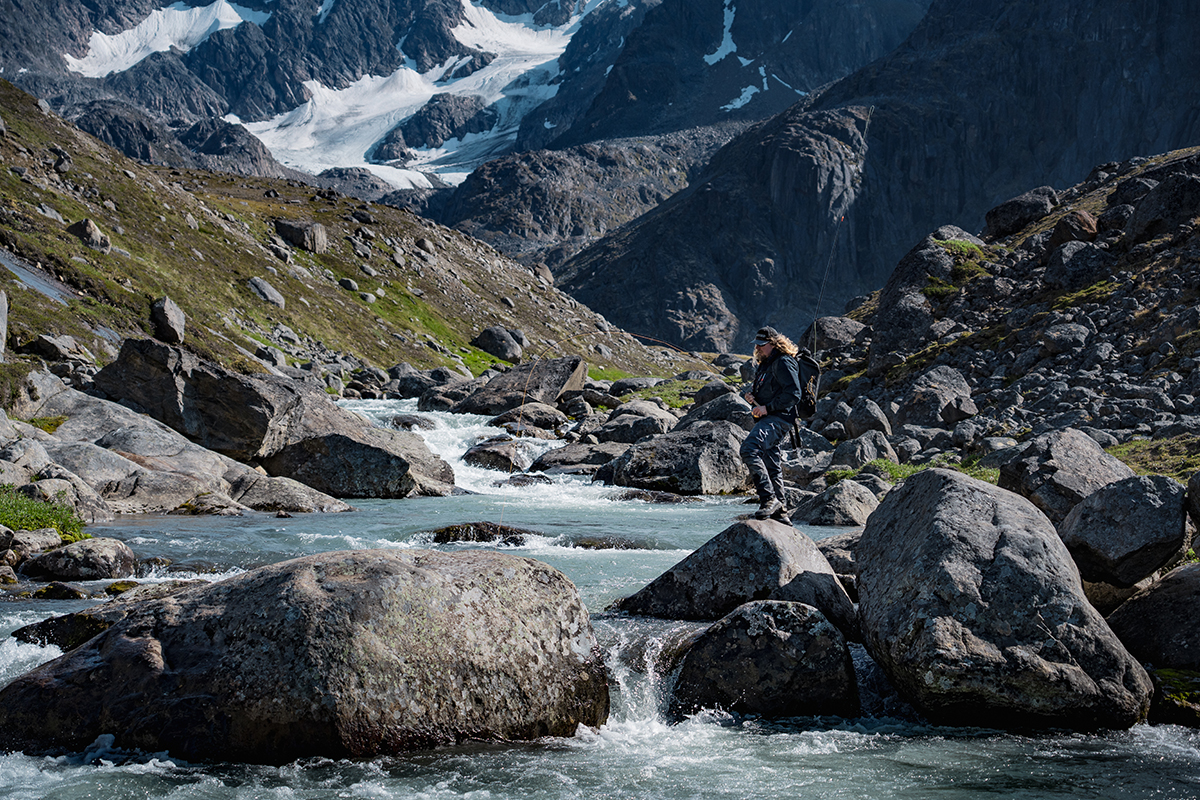
Finding the Trophy Arctic Char
Early in the season when the fish begin to run, the bigger fish can be a little harder to pick out from the bunch but generally they will take up the lowest part of the water column. I have also observed that like salmon, shoals of Arctic char will stick together both when going out to sea and when coming back into freshwater. This often means that when you find a 50cm fish, there are likely to be more in the same pool. Some days on these tidal runs it will be common for everyone to catch average size fish of only 45cm, or on another day it could be 55cm and the next another size range, as they are likely migrating together.
However as the season progresses, the old saying “this town ain’t big enough for the two of us” seems to begin to thin out the shoals, males will begin to take up likely spawning spots and or areas of the river where they feel they are the most protected. Typically this will be the deeper gullies by the gravel drop offs, where they can collect females and challenge competitor males. Or they will find outcrops in the high banks and below white waters, that create small back eddies, breaks in the water at depth, while the surface of the river still has some turbulence that masks and shields them from view of predators from above.
Early in the season these big fish sitting at depth are very difficult to spot with their silvery white flanks and turquoise green backs blending into the water colour, but as they begin to colour up, their distinctive bright orange and red bellies begin to give them away, even their backs can change to a vivid olive and yellow when caught by sunlight. Stalking the banks and searching carefully, observing to see where these fish hold up and what their behaviour is like, gives us a greater understanding and opportunity to target and catch these fish.
As more males arrive and become equal challengers, these opportunities for success greatly increase. Spending more time focusing on these areas and getting that one special fish to take, over blindly casting and swinging flies through every pool for high numbers of smaller fish and potentially the odd lucky big fish encounter has definitely become my main passion. Not only in fly fishing for Arctic char, but any fly fishing that I do now. There is no greater feeling for me than searching, finding and sight fishing these remarkable stunning fish.
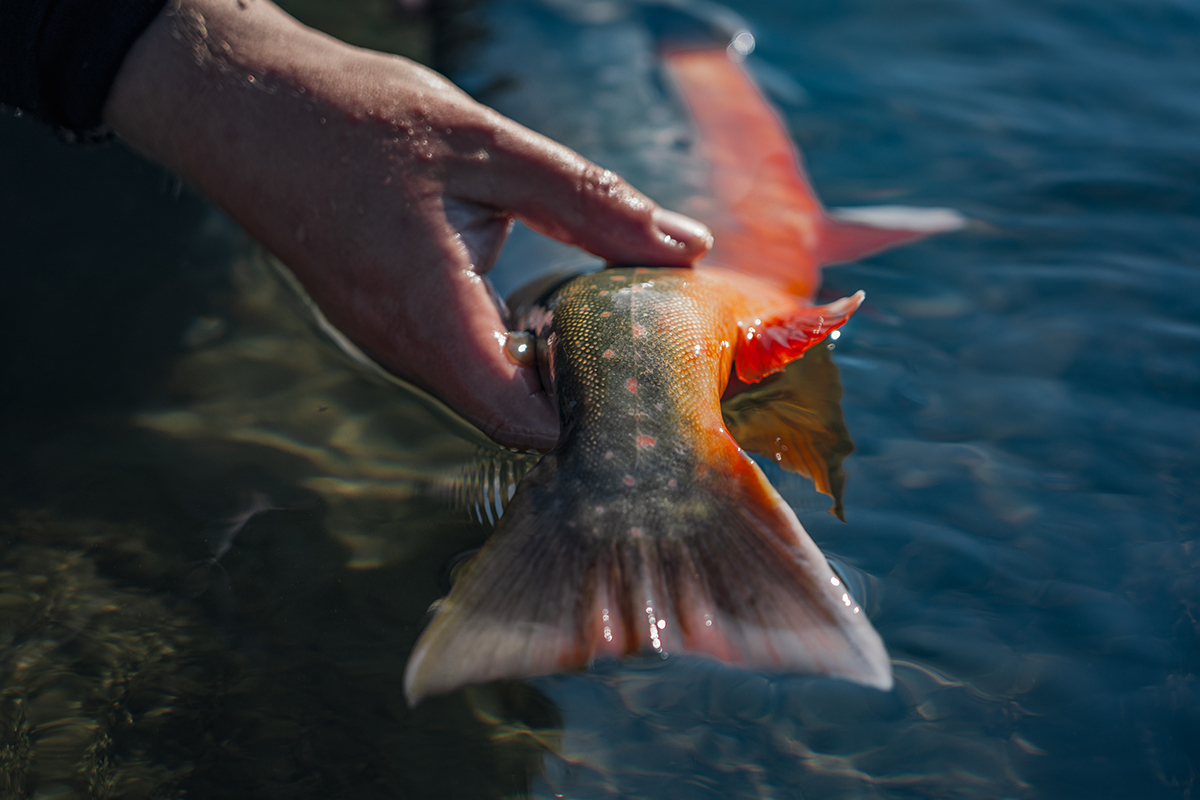
Catch and Release Arctic Char – Protecting Greenland’s Char
Currently, there are no dedicated conservation organisations for Arctic char in Greenland, which makes angler responsibility critical.
Best Practices
- Avoid blind fishing over dense shoals of fish to reduce chances of foul hooking
- Single barbless hooks to minimize damage and quick releases
- Rubber nets or in-water releases by grabbing the leader for safe handling
- Minimal photo handling, 2–3 seconds at a time a once or twice with a camera ready
- Always wait for full recovery before release, especially in fast currents. Try to release in calmer waters so they can continue to recover
These fish are a precious resource. Mature char will be in the range of 10–20+ years old, with the oldest known on record being over 40. We treat every catch with care to preserve the fishery for the future
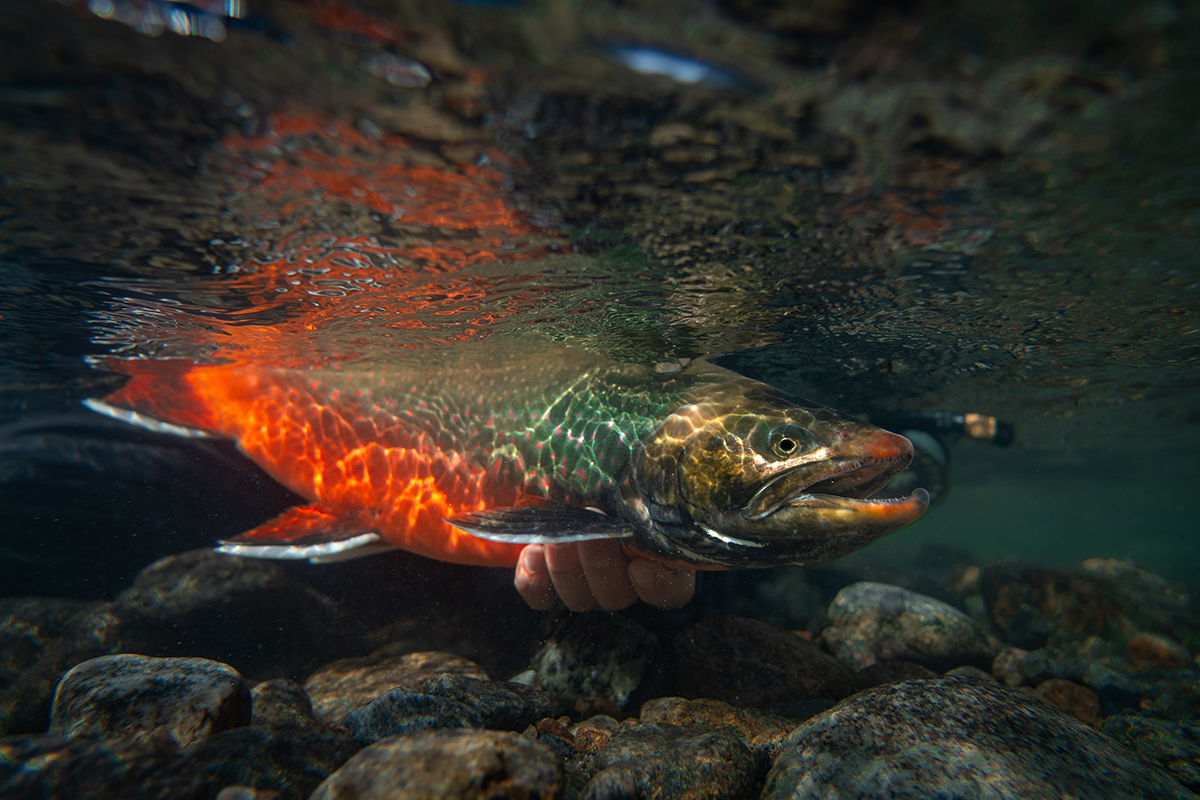
Packing Smart – Be Ready for Anything
A major advantage of carrying two rigs is the ability to switch tactics quickly without re-rigging. I rely on the Dry Backpack 25L, which allows me to strap on 1–2 rods while keeping my hands free for navigating Greenland’s rugged terrain.
This system makes it easy to fish a topwater rig to locate char, then quickly swap to a nymph rig if they refuse to rise and or having the Switch rig for distances if that is the plan for the day.
More than once, this flexibility has landed me a trophy fish and shamefully it has also prevented my fishing day from being halved when I broke a rod due to my own negligence.
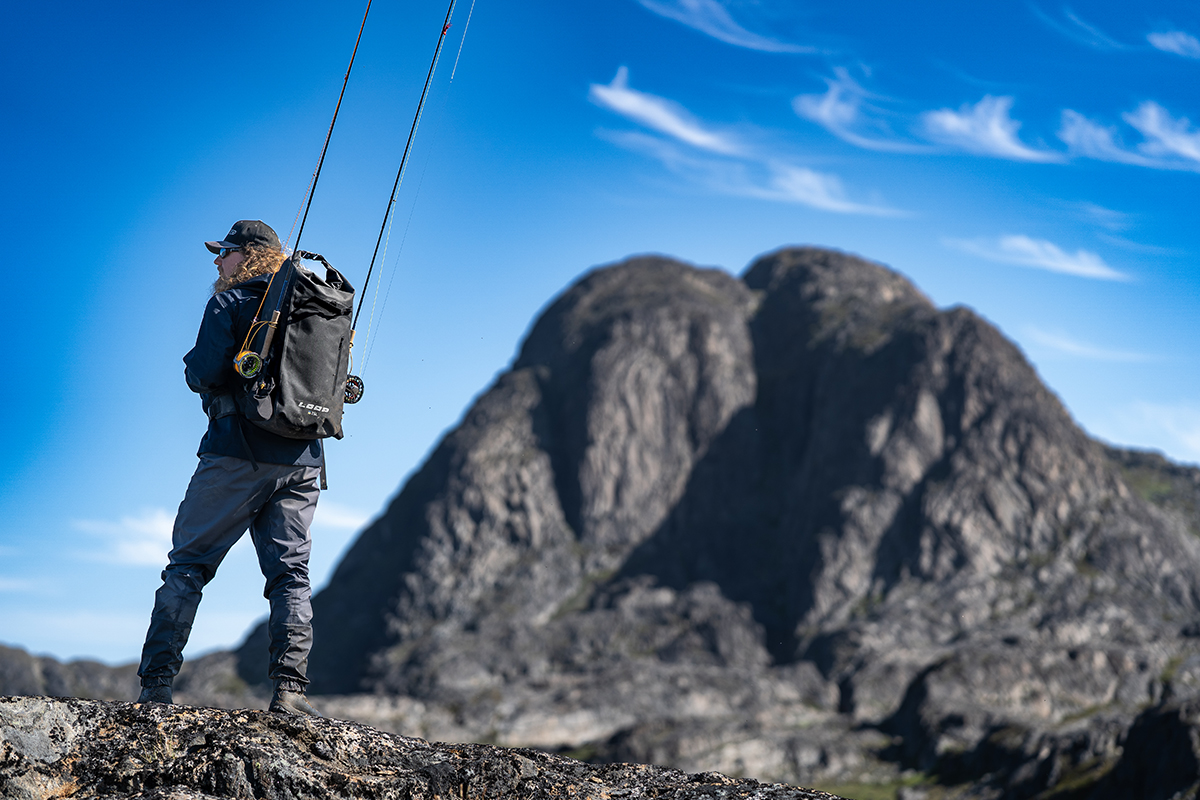
Final Thoughts
Chasing sea-run Arctic char in Greenland for me is one of the most thrilling adventures in fly fishing. With the right setups, tactical rigs, and a conservation-first mindset, you’ll not only catch more, bigger fish, but also ensure this incredible species continues to thrive for years to come. I hope to take my kids to Greenland one day and I sure wish that they don’t have the same experience that I did as a child fishing for Atlantic salmon & sea trout, hearing old stories of how it used to be.
Given that there are so many fish (like the good old Salmon days), sea-run Arctic char in Greenland especially are often dismissed for being too easy or too many fish to enjoy fishing, which I really feel is a huge disservice to what is essentially a gift to any angler who loves to chase migratory fish and with out a doubt, pound for pound, the hardest fighting and most determined salmonid of all.
Not only are sea-run Arctic char in such healthy numbers that we are given a chance to avoid the same mistakes and hardships that have affected Atlantic salmon and sea trout, but it also provides ample opportunity to try and perfect many of the same techniques, developing new ones that could be beneficial to other migratory fishing tactics and for many the chance to experience what it could be like or how it used to be when our home rivers were at their best.
Loosing a fish here, even a trophy fish as devastating as that can be, you never feel like it was your one and only shot. The opportunities are in abundance, if you have the patience and desire to develop your fly fishing abilities and target the best these rivers have to offer, it is every bit as rewarding as the best days on any other migratory fish rivers around the world and for me there is no contest when it comes to the striking beauty of a big Arctic char in it’s full spawning regalia.
So strap your rigs to the backpack, settle in for a decent hike and get ready for explosive surface eats or a classic nostalgic swing through beautiful pools and that familiar pull, sight fishing with subtle takes, and the chance to connect with one of these stunning migratory fish jewels and the only one capable of surviving and thriving this far north – sea-run Arctic char.
